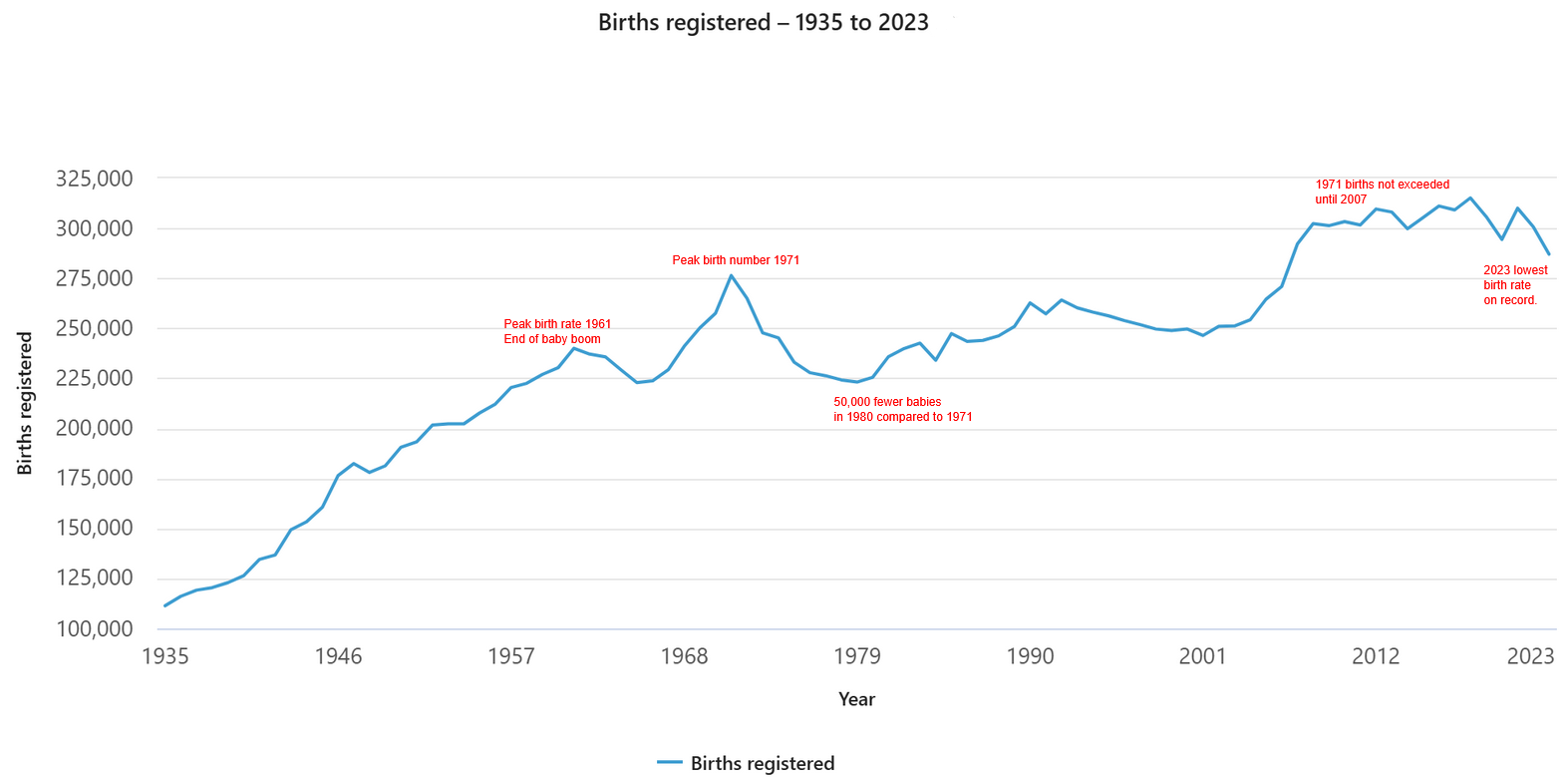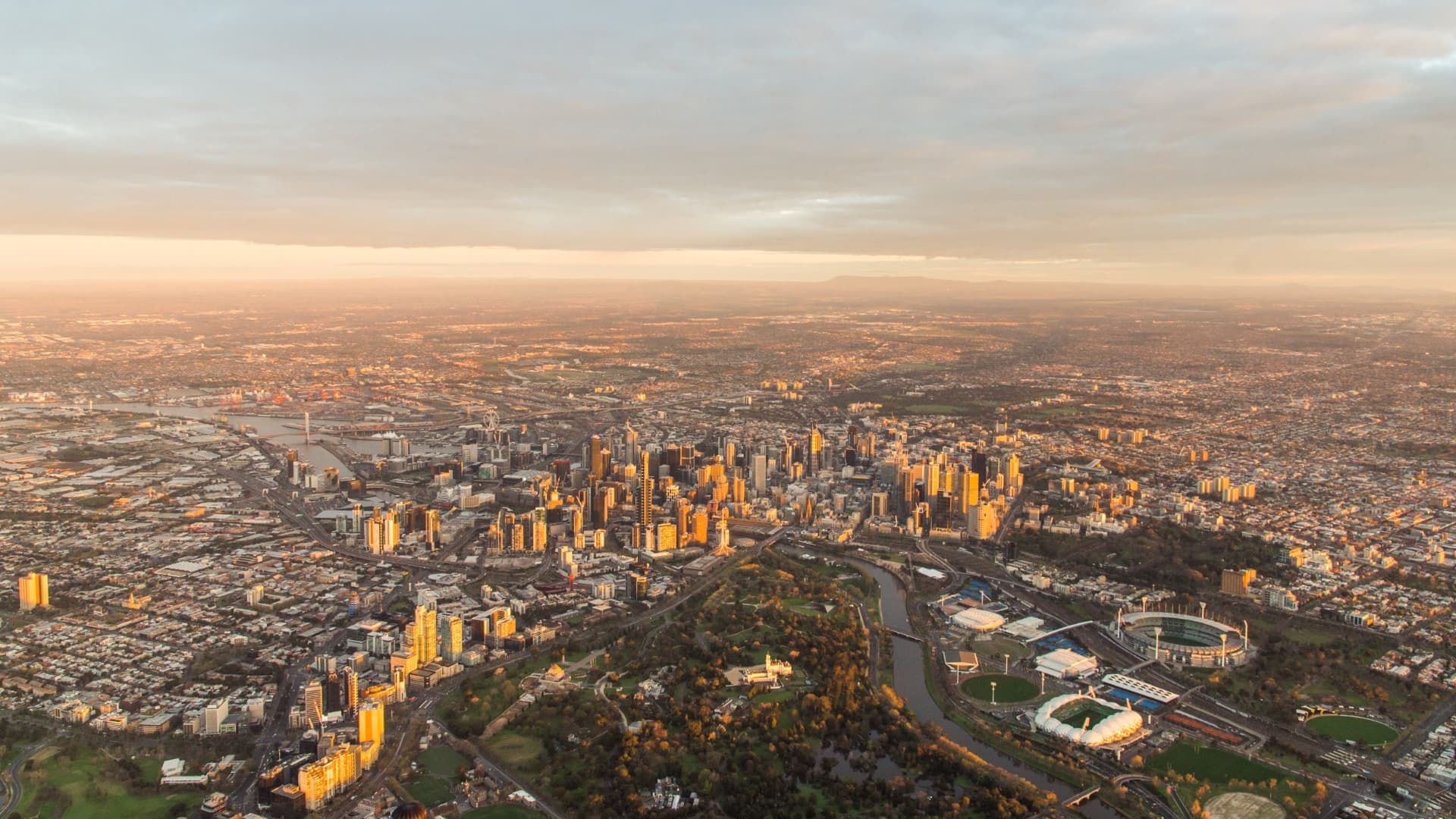The latest population numbers to December 2024 are out for Australia, States and Territories. Australia's population is still growing strongly, but the very high overseas migration we saw in 2022-23 and 2023-24 financial years is tapering off leading to slightly lower growth.
At December 31st, 2024, the population of Australia stood at 27,400,013 people, up by 445,900 people from the previous year, or 1.65%. That's down from a peak of 2.53% annual growth recorded at the height of the post-COVID migration boom in September 2023. This is the lowest annual growth rate recorded since June 2022 (1.30%) which was affected by border closures. Prior to that - we're back to the moderately high growth levels seen in the 2016-2017 period. Approximately 76% of Australia's growth came through net migration and the other 24% from natural increase (births minus deaths). Net migration has slowed each quarter since peaking in September 2023, with annual migration now at 340,750 for the calendar year 2024, down from 530,620 the year before (a record for a calendar year).
While it has slowed, the net migration is still higher than any year prior to 2022. Quarterly net migration was only 68,043 (Oct-Dec 2024), which would indicate an annual migration coming down to around 280,000 - in line with .id's population forecast assumptions. However the December quarter is traditionally the slowest quarter for migration each year (students come in during the March quarter) so it's likely to be a little higher than this.
We had 292,500 births in Australia for the calendar year, and 187,300 deaths, giving a natural increase in population of 105,100 people. While our birth rate is well below replacement level, at 1.50 - due to the current age structure of the population it will be at least another 20 years before Australia's population starts to experience natural decline (excluding migration).
Estimated Resident Population and annual components of change by State/Territory, December 2024
| State/Territory |
ERP December 2024 |
Change over previous year |
% change over previous year |
Natural Increase |
Net Overseas migration |
Net interstate migration |
% overseas migration |
| NSW |
8,545,140 |
108,056 |
1.28% |
29,444 |
106,730 |
-28,118 |
98.8% |
| Vic |
7,011,123 |
132,572 |
1.93% |
35,272 |
100,503 |
-3,203 |
75.8% |
| Qld |
5,618,765 |
102,756 |
1.86% |
19,939 |
56,877 |
+25,940 |
55.4% |
| SA |
1,891,670 |
20,673 |
1.10% |
2,709 |
19,546 |
-1,582 |
94.5% |
| WA |
3,008,697 |
70,312 |
2.39% |
12,576 |
45,124 |
+12,612 |
64.2% |
| Tas |
575,756 |
1,580 |
0.28% |
171 |
3,856 |
-2,447 |
244.1% |
| NT |
262,191 |
3,130 |
1.21% |
2,283 |
3,081 |
-2,234 |
98.4% |
| ACT |
481,677 |
6,838 |
1.44% |
2,801 |
5,005 |
-968 |
73.2% |
| Australia |
27,400,013 |
445,924 |
1.65% |
105,174 |
340,750 |
0 |
76.4% |
Source: ABS, National, State and Territory Population, December 2024
Two states have just hit major milestones, with Victoria's population reaching 7 million, and Western Australia reaching 3 million.
Only two states, WA and Queensland have positive interstate migration - all other states and territories are now negative. The ABS have made significant adjustments to the past few years interstate migration estimates, by using different sources such as Tax Office data to supplement Medicare change of address records and make these more accurate.
New South Wales grew by 1.28% for the year, substantially lower than the previous year's 2.25%, with Overseas Migration making up almost 100% of growth. The natural increase in NSW is almost exactly offset by interstate migration which is outwards. Traditionally NSW has the most interstate out-migration of any state, mainly to Queensland, but that trend is a bit smaller than previous years.
Victoria had the largest numerical growth and the second-highest percentage growth of any state or territory, with 1.93% increase, but falling below 2% now after almost hitting 3% a year ago. The population of Victoria has exceeded 7 million for the first time, with over 5 million of that in Greater Melbourne. Interstate migration has turned negative again with more people leaving than coming in. In the previous update it was slightly positive but ABS has revised this (see above) and Victoria hasn't seen a positive quarter of interstate migration since March 2020 (immediately pre-COVID). Victoria also had the largest natural increase of any state, over 35,000.
Queensland added 102,756 people with a growth rate of 1.86% for the 2024 calendar year, and gets the largest share of its growth from interstate migration, as a destination for people from all over Australia. Interstate migration to Queensland is particularly strong from NSW - the interstate loss from NSW is very close to the total Queensland gain. As a result of this it's also the state with the least reliance on overseas migration, which however still makes up more than half (55.4%) of the state's growth.
South Australia is the second-slowest growing state/territory adding 20,673 people, and at this rate will be about 5 years away from reaching the milestone of 2 million people. With an older population, natural increase is very low, less than +3,000 p.a. Interstate migration is now slighly negative, but quite small at about -1,500 p.a, and it has been revised up by the ABS for the last few years. During COVID SA gained population from interstate migration, and it hasn't gone back to the large interstate migration losses seen during the 2010s which peaked at around -7,000 p.a. Like NSW it gets close to 100% of growth from overseas migration, but at a much smaller level.
Western Australia is the fastest growing state, the only one with a growth rate that held above 2%. It's 2.39%, but down from over 3% in the previous year. WA added 70,312 people for the calendar year 2024, and all 3 components of change were strongly positive, with the largest share being over +45,000 net overseas migrants. As mentioned above, the state has punched through a key milestone of 3 million people. Despite being the largest state by area, has the most centralised population, with over 2.4 million of that (80%) living in Greater Perth (technically that's from the June 2024 figures, as capital city populations are only estimated annually).
Tasmania is by far the slowest growing state or territory, with a population growth of just 1,580 people or 0.28%, the only state/territory with growth under 1% in the 2024 calendar year. After a surprise increase at the last Census due to migration from the mainland during COVID, it has turned strongly the other way, and the main drag on growth is a -2,447 net interstate migration, which is a larger loss than SA, in a smaller population (our population forecasting team anticipated this trend in 2023). Natural increase is also very small, just +171 people. Due to an older age structure, Tasmania will likely be the first state to record negative natural change with more deaths than births. .id's National Forecasting Program shows this will probably occur as soon as 2027. Because of this, and somewhat counter-intuitively, Tasmania is also the state with the highest share of population growth due to overseas migration - it accounts for 244% of the growth (as the interstate component is negative).
The Northern Territory had moderate population growth of 1.21%, adding 3,130 people in calendar year 2024. It has the distinction of being the only state or territory to increase population growth from the year before, when it was 0.95%. Overseas migration is offset by significant losses interstate. It remains the lowest population of the states and territories, with 262,191 people.
The Australian Capital Territory has fallen back to a moderate growth rate a little below the national average, adding 1.44% or 6,838 people last year. The population sits at 481,677, closing in on its own milestone of half a million, likely to be reached around 2028. The ACT's interstate migration rate fluctuates but has been slightly negative for a few years now.
The December 2024 release of National Population Growth by the ABS is the half-year check-in point (population is normally estimated in financial years), and gives us an idea of what population and components of change are doing at a national and state level. Local area populations (including cities, SA2s and LGAs) are only released for the June quarter each year, and this is what appears on the the .id Community Profile and Economic Profile sites. We normally don't publish the quarterly estimates for States and Territories because they are used as benchmarks and for these interim time periods they don't match to any local numbers. The next major update to population numbers will be in March 2026, for June 2025 data.









